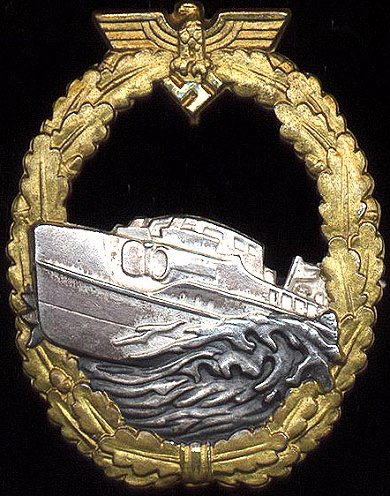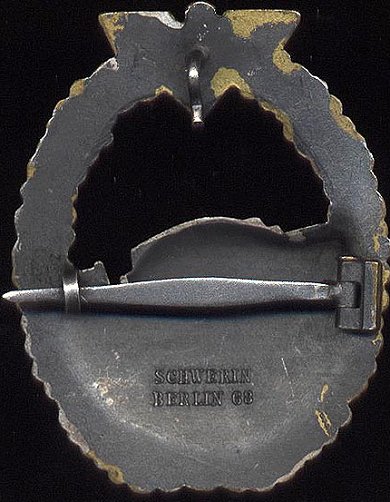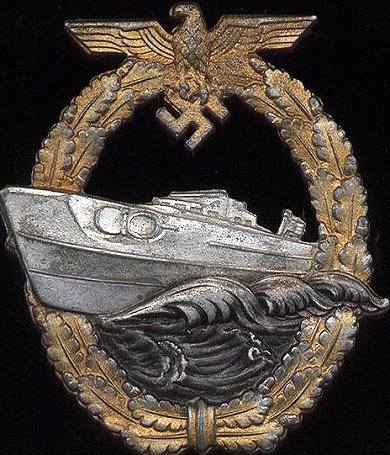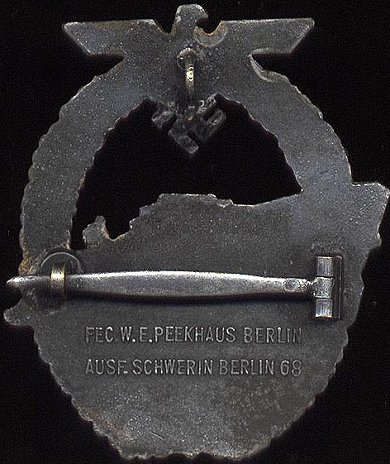
by Sebastián Bianchi
The E-boat Badge was first instituted on May 30, 1941 and was designed by Wilhelm Ernst Peekhaus of Berlin.
In 1941, the E-Boat offensive was stepped up and until that time E-Boat crews had received the same badge as the Destroyers.
Manufacturing and Technical Information
There are 3 known versions and they are referred to as, first type, second type and third type. Some of the known makers for the first type are Schwerin, second type: AS, AS (in a triangle), R.K., R.S., Schwerin, W.E. Peekhause, and for the third type: Mourgeon (Paris).
First Type: The badge is recognized by an E-Boat plowing through the sea. The boat has the appearance of coming through the wreath, from right to left, with the nose of the boat stopping at the center of the wreath. The boat is finished in silver, the sea is blue-black with the wave crests being burnished silver. The oak wreath which is finely gilded consists of seven bunches of 2 oak leaves with an acorn at each intersection of the oak leaves. At the bottom of the wreath, a tie is formed with a raised central band with a smaller edge to each side. At the top center of the wreath, the national emblem, a stubby winged eagle clutching a swastika also finely gilded. The reverse of the wreath is flat, with the reverse of the boat being scalloped in the more desirable cases. When a horizontal pin is used a small hook can be found at the top of the badge. This is to help secure the badge to the uniform. If the badge has a vertical pin the reverse is normally flat. The badge was usually presented in a blue box with a blue flock base, with white silk lid liner. The name of the badge was stenciled in silver on the upper lid of the box. This badge is considered rare because of its discontinued use soon after its inception. Measurements are 57 mm from the base to the top of the eagle's head and 45mm across the badge. The eagle's wingspan is 23.5mm and the height of the eagle including the swastika is 14mm. The wreath measures 7.5 mm across.


Photo Credit - M. Miller
Second Type: This type was designed again, by Wilhelm Ernst Peekhaus of Berlin in conjunction with Korvettenkapitan Rudolf Peterson and introduced into service in January 1943. It is not fully understood why the change in design other then the second type has a more modern looking E-Boat. On this type badge the wreath is flatter and the leaves are smaller and more delicate. The eagle at the top of the badge has a longer wingspan, the swastika will be either solid or open and hangs beneath the wreath. At the bottom of the wreath the tie has a more pronounced center band. The main difference between the first and second type is the E-Boat, a more modern one, cuts through the sea and actually goes beyond the left side of the wreath. The sea forms three waves that roll up on the side of the boat giving the appearance that the boat is moving fast. The third wave cuts through the right side of the wreath. The reverse has either a horizontal or vertical pin along with the maker's mark. If a horizontal pin is found there will also be a tiny hook at the top of the badge for attaching the badge to the tunic. The badge measures 60mm from bottom to top of the eagle's head and 53mm from tip of the boat to edge of the wave. The eagle's wingspan measures 36.5 mm with the height of the eagle and swastika being 20mm. The wreath measures 8mm across. The award was presented in a blue box with blue flock base with white silk lid liner.


Photo Credit - M. Miller
Third type: The French firm, Mourgeon in Paris, constructed the Third type. Its design is more like the First type. The reverse is silver, hollow struck and has a French pin and hinge. The badge measures 55mm from the base to the top of the eagle's head and 41mm across. The eagle's wingspan is 27mm, and height of the swastika and eagle are 14mm. The wreath measures 7mm across.
Presentation, Wear and Documents
The badge was wrapped in tissue paper and presented in a buff box in two parts with the edges stapled. The award was made through the E-Boat Captain with an award document and was worn on the left breast pocket beneath the Iron Cross First class or similar award.
Award Criteria
The award was presented to German crews for the achievements of successful attacks against enemy shipping. In case of death the award was presented posthumously. Besides good conduct and distinction the award criteria is as follows;
- A minimum of twelve enemy actions.
- When the mission was particularly successful and the individual displayed leadership or was killed in action.
- Special circumstances of being wounded in action or survivors of ships sunk by enemy action.
- To have performed a heroic action for which no other decoration was presented.
![]()
© Copyright Wehrmacht-Awards.com LLC |